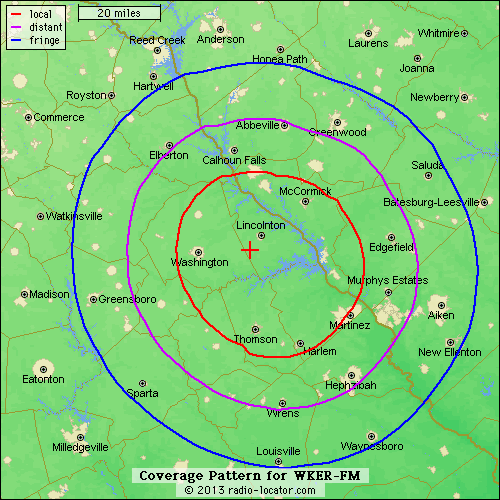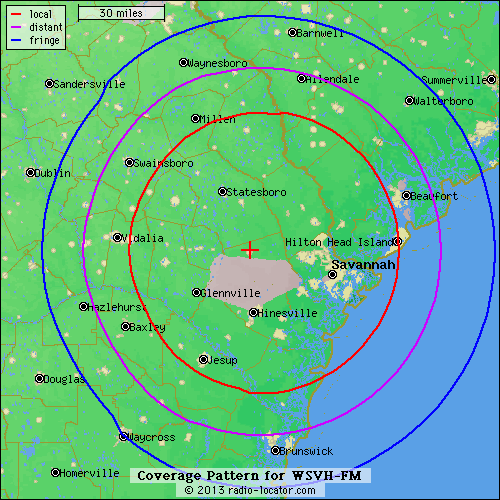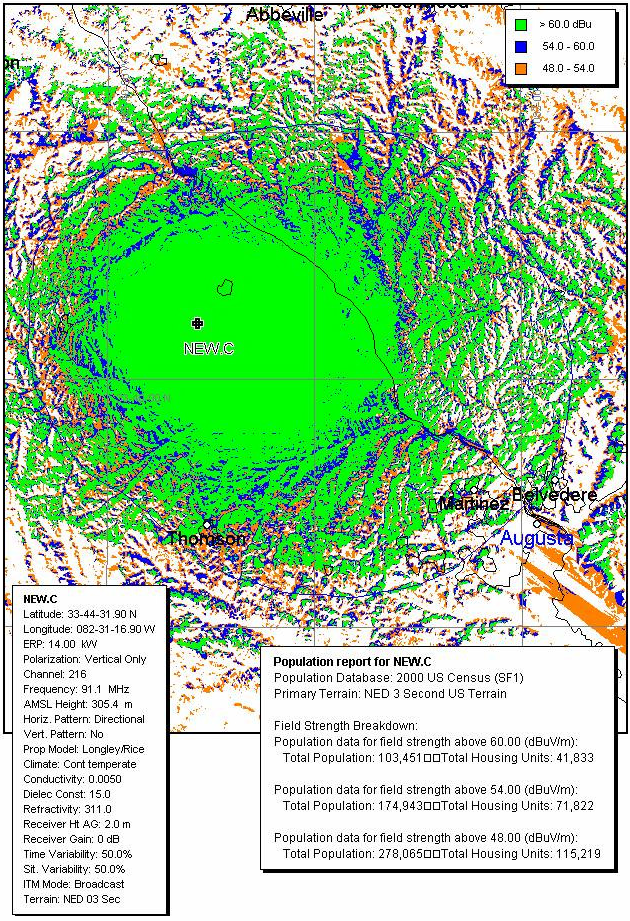Why can’t I get the station in the morning or evening hours?
During certain times of the year, an atmospheric phenomenon called “thermal inversion” affects our signal. Basically, cool, humid air occasionally gets trapped below a blanket of warm air. The signal then “skips” along the top side of the warm air blanket, reflecting it into space—it can’t penetrate the cold air down to your radio. The problem is worse in the early mornings, just after the coolest part of the night. There is nothing that we can physically do. Fortunately, the problem resolves itself as the rising sun warms the earth and the air layer above it, usually taking place as the morning progresses. All that to say there isn’t much that can be done—except hang in there with us!
Why is reception good one moment, while not as strong the next?
Being an FM station, reception might be sometimes thwarted by various characteristics common to VHF radio signals and the way they travel about space. Mobile listeners might experience flutter, or picket-fencing. Home listeners might hear signal fading or (more likely) a cancellation (multipath) of the signal caused by reflections arriving out of phase with the “direct” signal at the antenna. FM radio signals will bounce off of buildings, poles, vehicles, and hills (all of which can also block a signal, creating a “shadow”), as well as be absorbed by trees. It’s likely that your receiver is actually “seeing” many 91.1 FM signal reflections, however you only hear the strongest of the bunch.
It’s a complicated path that the FM radio waves travel before they get to your radio. And these conditions can and will change according to season and over time. Trees grow. Leaves come and go. Buildings go up. Where you place your radio receiver or antenna within a room can make all of the difference, and just because one location worked great for twenty years, that doesn’t guarantee it will be ideal next week.
How might I improve my reception?
One of the easiest solutions to a reception problem is to move the radio to a different part of the room. Moving the radio only a few inches or several feet sometimes will bring in a clear signal. Most portable and clock radios use either a telescopic whip or the AC power cord as an antenna. The whip can be extended, retracted, and rotated to change reception. The AC cord can be moved around and draped across objects for the best signal or wrapped up to reduce signal. If your clock radio has no visible antenna or connections for an antenna then the radio is likely using the power cord for an antenna.
For radios with a coaxial connector, an electrically-amplified set of rabbit ears is the most effective way of boosting the WKER signal. These can be purchased for around $30 and sometimes less, at retail stores. Move it to the right location in your home, turn up the amplification, and then move the rabbit ears into just the right position.
Does my radio need an antenna?
Stereo tuners and receivers require an external antenna — an antenna that is not a part of the radio. Many tabletop and clock radios have connections for an external antenna, but also allow you to use the power cord if you don’t want to use an external antenna.
The antenna connects to either two screw terminals marked 300 Ohm or an “F” connector for coaxial (round) cable located on the back of the unit. A “twin-lead” dipole antenna is usually boxed with a new receiver or tuner. Many people attach this dipole antenna to their new set and then ball it up and stuff it behind the equipment. For strong stations this may work just fine, but for weak stations it will not work. If you don’t have an antenna connected to your stereo, you can purchase or make a dipole.
The dipole consists of about five feet of flat antenna lead-in wire with the ends bared and twisted together. Another five feet of wire is attached to the center of the first piece of twin-lead at the middle of ONE of the wires by cutting it, baring the wire, then twisting it together.
The dipole has a “figure-of-eight” reception pattern. It picks up signal on the broad sides of the antenna, provides some antenna gain, and receives no signal on the ends. If the dipole is stretched out and rotated, it’s possible to point the antenna for best reception or to “null” a station that is interfering with the desired signal. The disadvantage of the dipole is finding a way to locate it in the room. If you are lucky, the direction of the desired station will correspond with one of the walls in the room and you can simply attach the stretched out twin-lead to the wall. Some people mount the dipole on a “TEE”-shaped frame made of wood and position it in the room for best reception. Others have mounted this same frame in the attic.
It may be easier to buy a “rabbit ear” antenna like you would use for television reception. The rabbit ear is another form of dipole antenna. Each telescopic section should be adjusted for a length of 31.75 inches. The rabbit ear is often easier to place in the room or on the stereo and can still be rotated for best reception.
There are a number of indoor specialty antennas available for FM reception. Some work very well and some do not; ensure that the antenna could be returned before purchasing it.
Okay, so why do I need to worry about how my antenna is set up?
Both TV and FM reception are referred to as “line-of-sight.” This means the transmitting and receiving antennas must be able to “see” each other. For reception farther away from the transmitter site, a roof or attic-mounted antenna is recommended, both for the increased height and for the additional antenna gain (the increase in signal strength over a reference antenna) that comes with a directional antenna. Directional antennas also may be mounted in the attic, still providing increased height over lower level locations.
A directional antenna can help in reducing “co-channel” interference from a station on the same frequency as the desired station but located in a different direction—or adjacent channel stations that are interfering with the desired station. People who listen to a number of distant radio stations often use a rotator to position the antenna correctly for each station. Directional antennas can be found at some electronic stores, as well through many TV and antenna dealers, who will also stock higher gain antennas. Be wary of the antenna claims of long distance reception. Unless you have a high tower for your antenna, curvature of the Earth prevents reception from very long distances. Be more interested in whether the antenna has 3 db, 6 dB, or 9 dB of gain. The more gain the better for distant stations but, the antenna is going to be larger for each increase in gain.
Will an amplifier help reception?
You should also be aware that an amplifier, either a pre-amp at the antenna or a distribution amp in the house, won’t produce a better signal. Only antenna gain will give you a better signal over noise. Amplifiers are used to make up for the signal losses in long runs of cable, such as from the roof or tower mounted antenna into the house, or from splitting the signal to feed multiple sets. The amplifier should always be inserted before the loss occurs.
How do I mount an outdoor antenna?
If you install an attic or outdoor antenna, be sure to follow good engineering practices by twisting the twin-lead (flat) cable and mounting on stand-offs, or by using coax (round) cable. Always ground the antenna and the lead-in cable. Always use “splitters” or “couplers” for multi-set installations or joining several antennae to one lead-in cable. These practices insure the rejection of unwanted and interfering signals being picked up by the cable (or sometimes retransmitted by YOUR antenna to the neighborhood) and afford protection against lightning. Books on proper antenna and lead-in installation can be found in many libraries or at electronic stores.
Why is WKER’s signal range the size that it is?
Simply put, the Federal Communications Commission (FCC) has rules that regulate how much stations that share the same frequency (co-channels with WKER 91.1 FM) and their first adjacent channels (90.9 FM and 91.3 FM) can overlap in strength. There are many calculations that go into these regulations such as distance, terrain, antenna height, etc. – for extensive details on these rules, click on this link and see 47 CFR Part 73.507 to 509.
On the map below, the bold circles represent an estimate of the coverage of WKER and the other curves around the state represent other area co-channel and adjacent channel stations’ coverage:
Red represents the city-grade protected contour of each station in which there should be no interference between co-channels and 1st adjacent channels.
Purple represents the distant contour in which only a small percentage of overlap is allowed between co-channels and 1st adjacent channels.
Blue represents the fringe contour, in which there can be some expected and allowed overlap in signal.
As, you can see, we are not allowed to expand our station’s reach due to these rules on interference. However, using the information listed above, WKER can be picked up quite well, even to the fringe signal strength represented on the maps below.
Longley Rice Map for WKER-FM





